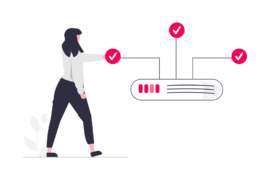The year was 2015, header bidding emerged as an answer to problems presented by waterfall auction. It has now become the first choice for many publishers. However, until 2017, the eMarketer survey showed that only 21% professionals (publishers, advertisers, and marketers) have a good understanding of the header bidding ecosystem.
Header bidding is complex and requires technical understanding to implement correctly. Still, some publishers choose to implement header bidding without completely understanding its mechanics, and find themselves tangled in bids and time outs. So, here’s how publishers should prepare and get started with header bidding.
Start By Asking, ‘Is Header Bidding a Fit For Me?’
Header bidding requires technical knowledge. If you, as a publisher, are well equipped with a (technical) team to work on the header bidding wrapper, you’re in a good place. If not, you will need to create one. Apart from technical aspect, you will also require a team (AdOps) to monitor and manage yield, user experience, and demand relationships.
“Header tag integrations require a much, much heavier upfront lift in terms of trafficking line items. It’s not just a little more work, it’s probably 100X as much work to traffic for most publishers.” stated Ben Kneen, a thought leader on Header Bidding.
If you use other means to sell your inventory (like AdSense), there are chances that implementing header bidding might adversely affect your earnings initially, thanks to the fluctuations in CPMs, fill rate, and page load time to name a few.
Read and Learn About Header Bidding
Familiarize yourself with how header bidding works, what it can do, and what it cannot get done. Learning about basic terminology is a good start.
Header bidding wrapper: It is a JavaScript framework used to manage multiple demand partners and set rules for the auction, like timeout settings, remove/add demand partners, etc. There are options like open-source wrappers like Prebid.js as well as proprietary wrappers available for publishers.
Client-side header bidding: Here, auction runs on the user’s browser. The benefits include cookie syncing which results in better audience targeting, but on the other hand, this can lead to increase in page load time.
Server-side header bidding: This kind of header bidding auction runs on the server. It reduces the page load time providing the flexibility to add as many demand partners as possible. Although, this comes at the cost of limiting the cookie syncing ability leading to lesser ad network audience match.
Further, you may want to know about the pros and cons of header bidding and what the future holds for it. Currently, industry players like Rubicon see mobile-first advertising and hybrid approach as the inevitable future. Similarly, read about what professionals think about the future of header bidding.
Prepare for Challenges
Third-party tags that enable header bidding to slow the page down. This makes more visitors abandon your web page before it loads, leading to bad user experiences and ultimately loss of revenue.
Given the initial fluctuations in revenue, you must have a blueprint for short-term and long-term plans. Short-term plans mark small targets like understanding the bidding process and creating a robust platform with demand partners. Long-term plans, however, should revolve around methods to increase ad revenue through bidder and timeout optimization.
Choose Header Bidding Partners Wisely
Choosing a header bidding partner can be tough. You must put good research into finding the best partners in your niche and location. But make sure they do not affect your page load time.
Some popular header bidding partners are:
- Appnexus
- Criteo
- Index Exchange
- AOL/Oath
- Amazon A9
Finally, Test It Before Implementing It
Header bidding makes sure publishers are handsomely rewarded for their inventory, but not without putting testing in action. A/B testing with bidders helps to increase the overall revenue and enables publishers to understand what works best for their inventory.
But where should the testing focus?
Errors: Watch out for any kind of errors. It could be a partner not returning a creative, timing out a lot, or keeping the bid rate unusually low.
Demand Partners: Adding too many demand partners is not always a good idea. It makes the auction (client side) slow. Take your time to find a good balance between demand partners to run a profitable auction. It is a good practice to compare the partners based on response time, bid rates, and bid winning rate percentage to choose the best demand partners.
Earnings: Finally, monitor your earnings for each individual test that you run and compare the results. By the end of the experiment(s), you will have the right model (partner, timeouts, etc.) ready to run the most optimized setup for header bidding.
Header Bidding, if done right, can lead to better CPM’s, positively affecting the bottom line, i.e. ad revenue.
AdPushup’s Header Bidding Solution
Merely deploying header bidding in your ad stack isn’t enough. Consistently optimizing it with technical improvements is the need of the hour. This is what AdPushup’s header bidding solution does. Through our multiple optimization features using data science and machine learning, we help publishers maximize their yield.
With our header bidding solution, you get:
- Automatic demand partner selection according to optimum requirements
- Smart timeout management
- Freedom to bring your own demand
- Bid monitoring and discrepancy resolution
Read more about our product capability: Header Bidding

Shubham is a digital marketer with rich experience working in the advertisement technology industry. He has vast experience in the programmatic industry, driving business strategy and scaling functions including but not limited to growth and marketing, Operations, process optimization, and Sales.







